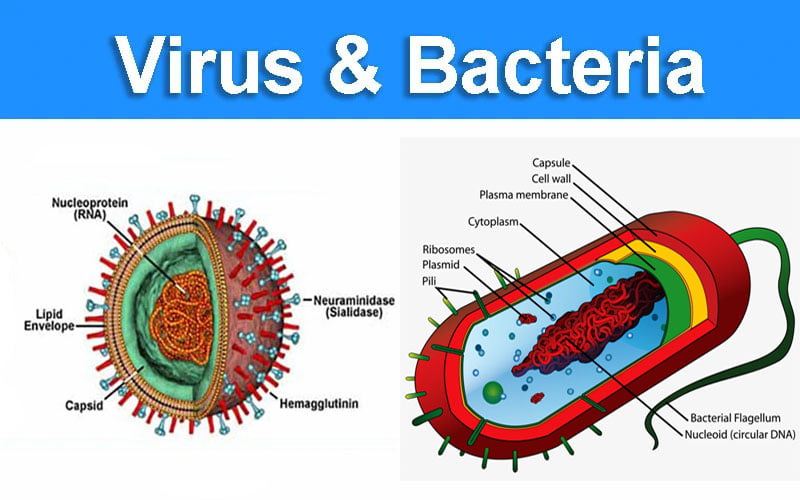
The perpetual battle between viruses and bacteria has shaped the course of life on Earth. Both microscopic entities play significant roles in various ecosystems, and understanding their differences is crucial to our knowledge of infectious diseases, medical advancements, and even biotechnology. In this article, we will delve into the depths of how viruses are different from bacteria at the apex of their comparison.
To grasp the dissimilarities “How Are Viruses Different From Bacteria Apex” , we must first comprehend their distinct characteristics, behaviors, and evolutionary paths. Let’s explore these key distinctions:
| Viruses | Bacteria |
|---|---|
| Viruses are much smaller than bacteria and are considered non-living entities. | Bacteria are unicellular organisms with a complete cellular structure. |
| The viral structure consists of genetic material (DNA or RNA) surrounded by a protein coat. | Bacteria have a complex cellular structure with a cell wall, cell membrane, and genetic material (DNA) contained within the nucleoid region. |
| Viruses | Bacteria |
|---|---|
| Viruses cannot reproduce independently and rely on host cells to replicate. | Bacteria can reproduce independently through binary fission, doubling their population rapidly. |
| Viral replication involves the injection of their genetic material into the host cell, hijacking the cellular machinery to produce new viral particles. | Bacterial reproduction is a straightforward process, where one bacterial cell divides into two identical daughter cells. |
| Viruses | Bacteria |
|---|---|
| The life cycle of a virus includes the phases of attachment, entry, replication, assembly, and release. | Bacteria have a typical life cycle consisting of growth, DNA replication, and cell division. |
| Viral infection often leads to the destruction of the host cell during the release stage. | Bacterial division does not involve the destruction of the parent cell. |
| Viruses | Bacteria |
|---|---|
| Viruses can have either DNA or RNA as their genetic material, but not both. | Bacteria possess DNA as their genetic material. |
| The genetic material of viruses can be single-stranded or double-stranded. | Bacterial DNA is typically double-stranded, organized in a circular chromosome. |
| Viruses | Bacteria |
|---|---|
| Viruses lack cellular machinery and do not carry out metabolic processes. | Bacteria are metabolically active and can perform various cellular functions. |
| As non-living entities, viruses do not require energy or nutrients for survival. | Bacteria obtain energy through various metabolic pathways. |
| Viruses | Bacteria |
|---|---|
| Antibiotics are ineffective against viruses since they lack cellular structures targeted by antibiotics. | Antibiotics can effectively target and treat bacterial infections. |
| Antiviral medications are specifically designed to combat viral infections. | Bacterial antibiotic resistance has become a concerning global health issue. |
| Viruses | Bacteria |
|---|---|
| Viruses are responsible for a wide range of infectious diseases, from the common cold to more severe illnesses like COVID-19. | Bacterial infections cause diseases such as strep throat, tuberculosis, and urinary tract infections. |
| Vaccines play a vital role in preventing viral infections, providing immunity against specific viruses. | Vaccines can also prevent some bacterial infections, like the ones caused by Haemophilus influenzae and Streptococcus pneumoniae. |
| Viruses | Bacteria |
|---|---|
| Viruses can have a narrow or broad host range, infecting specific species or multiple species. | Bacteria have a diverse host range, and some species are capable of infecting various organisms. |
| Viruses | Bacteria |
|---|---|
| Viruses are used in genetic engineering and biotechnology to introduce specific genes into host cells. | Bacteria are essential in biotechnology for producing various substances, including insulin and enzymes. |
| Viral vectors are employed in gene therapy research and medical applications. | Bacterial fermentation is used in the production of food products like yogurt, cheese, and pickles. |
| Viruses | Bacteria |
|---|---|
| Viruses are significantly smaller, ranging from 20 to 400 nanometers in size. | Bacteria vary in size, with most measuring between 0.5 to 5 micrometers. |
| Viruses | Bacteria |
|---|---|
| The origin of viruses remains a subject of scientific debate, with theories suggesting they may have evolved from cellular organisms. | Bacteria are ancient life forms, with a fossil record dating back billions of years. |
| Viruses | Bacteria |
|---|---|
| Viruses are recognized by the immune system through specific antigens on their protein coats. | Bacteria are detected by the immune system through their cell wall components and other surface structures. |
| Viruses | Bacteria |
|---|---|
| Antiviral drugs are designed to target specific viral components and inhibit their replication. | Antibiotics are used to kill or inhibit the growth of bacteria. |
| Viruses | Bacteria |
|---|---|
| Some viruses can survive extreme conditions, such as extreme heat or cold. | Certain bacteria are known for their ability to survive in extreme environments like acidic hot springs and deep-sea hydrothermal vents. |
| Viruses | Bacteria |
|---|---|
| Influenza virus, HIV, SARS-CoV-2, and Herpes simplex virus are well-known viral examples. | Escherichia coli, Streptococcus, and Staphylococcus aureus are common bacterial examples. |
| Viruses | Bacteria |
|---|---|
| Viruses play a significant role in controlling bacterial populations, which in turn influences ecosystem balance. | Bacteria are crucial in nutrient cycling, decomposition, and soil enrichment. |
| Viruses | Bacteria |
|---|---|
| Some viruses can establish mutualistic or parasitic relationships with their hosts. | Bacteria can form symbiotic relationships with various organisms, including humans. |
| Viruses | Bacteria |
|---|---|
| Viral zoonoses are diseases that can be transmitted from animals to humans. | Bacterial zoonoses are infectious diseases caused by bacteria that can be transmitted from animals to humans. |
A: Yes, some viruses known as bacteriophages specifically infect and replicate within bacterial cells.
A: No, while some bacteria cause diseases, many bacteria are beneficial and essential for various physiological processes.
A: Bacteria can develop resistance to bacteriophages through the modification of their cell surface receptors.
A: Viruses can jump from animals to humans through a process called zoonotic transmission, which occurs when humans come into close contact with infected animals or their environment.
A: Viral reassortment, also known as genetic shift, can lead to the emergence of new viral strains with the potential to cause pandemics, as seen with the influenza virus.
A: Yes, the human gut harbors trillions of beneficial bacteria that aid in digestion, produce essential nutrients, and support the immune system.
In conclusion, understanding “How Are Viruses Different From Bacteria Apex” of their comparison is crucial for comprehending their impact on human health, ecosystems, and technological advancements. While both entities have unique attributes, they collectively shape the intricate web of life on our planet. By exploring their distinct characteristics, behaviors, and roles, we can continue to unravel the mysteries of these microscopic powerhouses.
Recommended other topics: Chest Compression Feedback Device Monitor










© InfoDoot. All Rights Reserved.